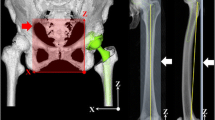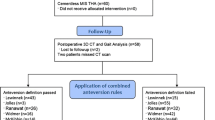Abstract
Introduction
This study examined whether the component position or muscle strength affects the cup-head translation under in vivo weight-bearing conditions after total hip arthroplasty (THA). We hypothesized that there was a correlation between the hip offset or abductor strength and cup-head translation during gait.
Materials and methods
We prospectively evaluated 31 patients undergoing unilateral cementless primary THA. The cup height, cup/stem offset, and limb length discrepancy were measured on anterior–posterior bilateral hip radiographic images. The isometric muscle strength of the lower limbs was quantified using a handheld dynamometer. Continuous radiographic images were recorded during gait, and cup-head translation was analysed using a computer-assisted method.
Results
The average cup height, cup/stem offset, and limb length discrepancy were − 3.8 ± 5.1 mm, 1.2 ± 5.2 mm/− 0.7 ± 7.7 mm, and − 2.1 ± 5.2 mm, respectively. The average hip abductor/flexor and knee extensor strength were 86% ± 18%/85% ± 17% and 88% ± 17% of the contralateral healthy hip, respectively. The average cup-head translation during swing phase of gait was − 0.003 ± 0.31 mm. Multiple regression analyses found no significant independent predictors of cup-head translation (p > 0.05).
Conclusions
The component position or muscle strength did not significantly influence cup-head translation during gait after well-positioned primary THA.





Similar content being viewed by others
References
Learmonth ID, Young C, Rorabeck C (2007) The operation of the century: total hip replacement. Lancet 370(9597):1508–1519
Nakashima Y, Sato T, Yamamoto T, Motomura G, Ohishi M, Hamai S et al (2013) Results at a minimum of 10 years of follow-up for AMS and PerFix HA-coated cementless total hip arthroplasty: impact of cross-linked polyethylene on implant longevity. J Orthop Sci 18(6):962–968
Hua X, Li J, Wang L, Jin Z, Wilcox R, Fisher J (2014) Contact mechanics of modular metal-on-polyethylene total hip replacement under adverse edge loading conditions. J Biomech 47(13):3303–3309
Blumenfeld TJ, Glaser DA, Bargar WL, Langston GD, Mahfouz MR, Komistek RD (2011) In vivo assessment of total hip femoral head separation from the acetabular cup during 4 common daily activities. Orthopedics 34(6):127
Harris WH (2012) Edge loading has a paradoxical effect on wear in metal-on-polyethylene total hip arthroplasties. Clin Orthop Relat Res 470(11):3077–3082
Dennis DA, Komistek RD, Northcut EJ, Ochoa JA, Ritchie A (2001) “In vivo” determination of hip joint separation and the forces generated due to impact loading conditions. J Biomech 34(5):623–629
Tsai TY, Li JS, Wang S, Scarborough D, Kwon YM (2014) In-vivo 6 degrees-of-freedom kinematics of metal-on-polyethylene total hip arthroplasty during gait. J Biomech 47(7):1572–1576
Elkins JM, Kruger KM, Pedersen DR, Callaghan JJ, Brown TD (2012) Edge-loading severity as a function of cup lip radius in metal-on-metal total hips—a finite element analysis. J Orthop Res 30(2):169–177
Komistek RD, Dennis DA, Ochoa JA, Haas BD, Hammill C (2002) In vivo comparison of hip separation after metal-on-metal or metal-on-polyethylene total hip arthroplasty. J Bone Joint Surg Am 84-A(10):1836–1841
Wiberg G (1939) Studies on dysplastic acetabula and congenital subluxation of the hip joint with special reference to the complication of osteoarthritis. Acta Chir Scand 83(Suppl 58):5–135
Crowe JF, Mani VJ, Ranawat CS (1979) Total hip replacement in congenital dislocation and dysplasia of the hip. J Bone Joint Surg Am 61(1):15–23
Nakashima Y, Hirata M, Akiyama M, Itokawa T, Yamamoto T, Motomura G et al (2014) Combined anteversion technique reduced the dislocation in cementless total hip arthroplasty. Int Orthop 38(1):27–32
Dastane M, Dorr LD, Tarwala R, Wan Z (2011) Hip offset in total hip arthroplasty: quantitative measurement with navigation. Clin Orthop Relat Res 469(2):429–436
Fukushi JI, Kawano I, Motomura G et al (2018) Does hip center location affect the recovery of abductor moment after total hip arthroplasty? Orthop Traumatol Surg Res 104(8):1149–1153
Lim YW, Huddleston JI 3rd, Goodman SB, Maloney WJ, Amanatullah DF (2018) Proximal femoral shape changes the risk of a leg length discrepancy after primary total hip arthroplasty. J Arthroplasty 33(12):3699–3703
Kamimura A, Sakakima H, Tsutsumi F, Sunahara N (2014) Preoperative predictors of ambulation ability at different time points after total hip arthroplasty in patients with osteoarthritis. Rehabil Res Pract 2014(861268):1–7
Stilling M, Kold S, de Raedt S, Andersen NT, Rahbek O, Soballe K (2012) Superior accuracy of model-based radiostereometric analysis for measurement of polyethylene wear: a phantom study. Bone Joint Res 1(8):180–191
Sato T, Nakashima Y, Akiyama M, Yamamoto T, Mawatari T, Itokawa T et al (2012) Wear resistant performance of highly cross-linked and annealed ultra-high molecular weight polyethylene against ceramic heads in total hip arthroplasty. J Orthop Res 30(12):2031–2037
Hamai S, Nakashima Y, Mashima N, Yamamoto T, Kamada T, Motomura G et al (2016) Comparison of 10-year clinical wear of annealed and remelted highly cross-linked polyethylene: a propensity-matched cohort study. J Mech Behav Biomed Mater 59:99–107
Glaser D, Dennis DA, Komistek RD, Miner TM (2008) In vivo comparison of hip mechanics for minimally invasive versus traditional total hip arthroplasty. Clin Biomech (Bristol, Avon) 23(2):127–134
Komistek RD, LaCour MT, Sharma A (2015) Proceedings of 2nd annual Pan Pacific orthopaedic congress; 22–25 July; Kona, the Big Island. Hwaii, USA. Conference supplement
Ogawa T, Takao M, Hamada H, Sakai T, Sugano N (2018) Soft tissue tension is four times lower in the unstable primary total hip arthroplasty. Int Orthop, Mar 27
Rasch A, Dalen N, Berg HE (2010) Muscle strength, gait, and balance in 20 patients with hip osteoarthritis followed for 2 years after THA. Acta Orthop 81:183–188
Judd DL, Dennis DA, Thomas AC et al (2014) Muscle strength and functional recovery during the first year after THA. Clin Orthop Relat Res 472:654–664
Harris WH (1969) Traumatic arthritis of the hip after dislocation and acetabular fractures: treatment by mold arthroplasty. An end-result study using a new method of result evaluation. J Bone Joint Surg Am 51(4):737–755
Acknowledgements
Source of funding: This work was supported by JSPS KAKENHI Grant No. (25870499) and a grant from the Nakatomi Foundation.
Funding
This study was funded by JSPS KAKENHI Grant No. (25870499) and a grant from the Nakatomi Foundation.
Author information
Authors and Affiliations
Corresponding author
Ethics declarations
Conflict of interest
The authors declare that they have no conflict of interest.
Additional information
Publisher's Note
Springer Nature remains neutral with regard to jurisdictional claims in published maps and institutional affiliations.
Rights and permissions
About this article
Cite this article
Kiyohara, M., Hamai, S., Hara, D. et al. Do component position and muscle strength affect the cup-head translation during gait after total hip arthroplasty?. Eur J Orthop Surg Traumatol 29, 1263–1269 (2019). https://doi.org/10.1007/s00590-019-02443-1
Received:
Accepted:
Published:
Issue Date:
DOI: https://doi.org/10.1007/s00590-019-02443-1




